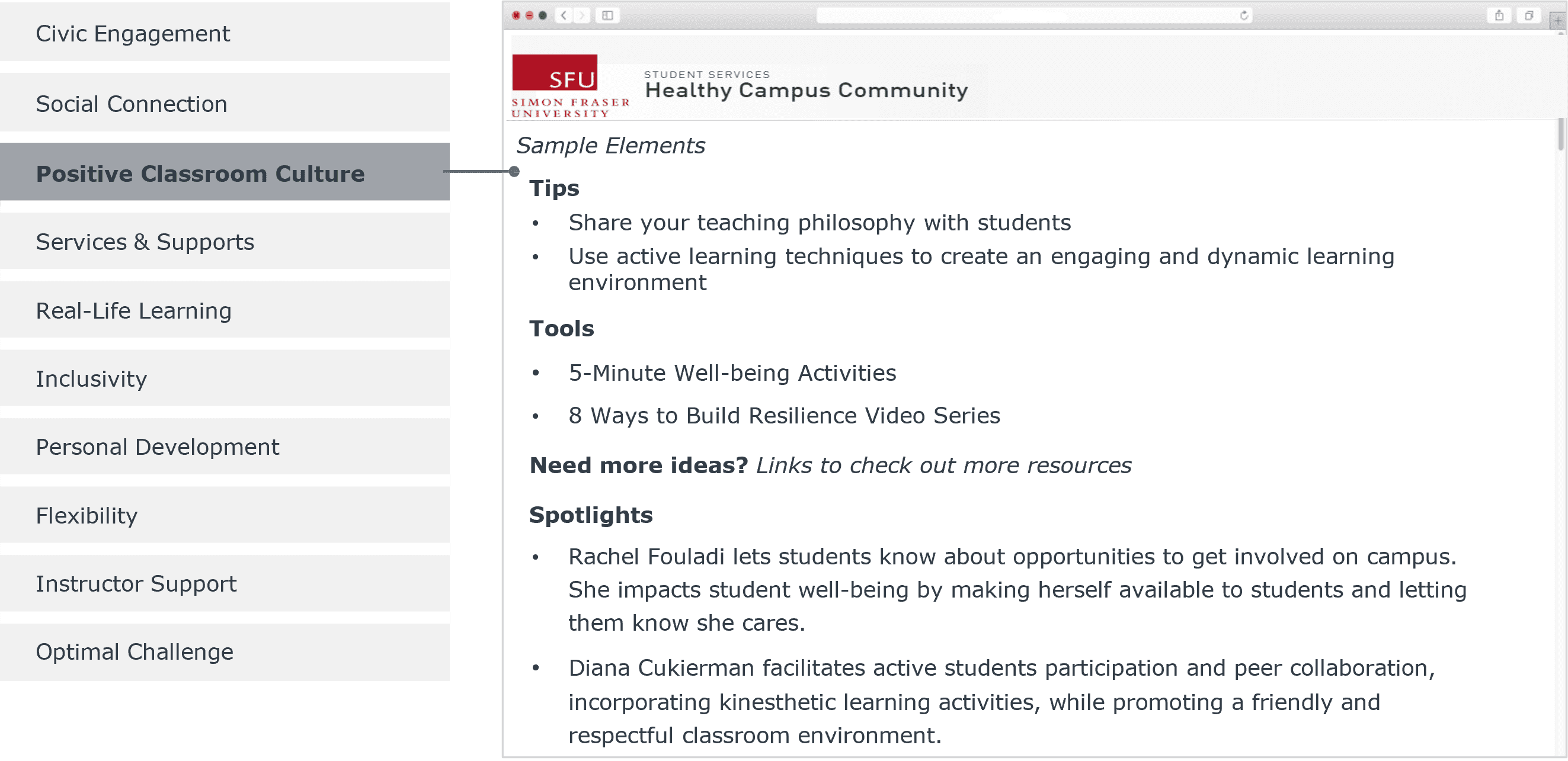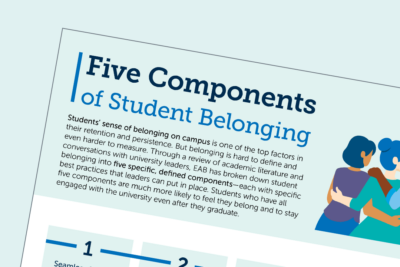3 ways to equip faculty to support student mental health

Student mental health is at the forefront of institutional concerns as the demand for campus mental health services continues to rise. Faculty can play an important role in student mental health by acknowledging mental health challenges and promoting and being liaisons to support resources. But, while nearly eight out of ten professors had a 1-on-1 conversation with a student about mental health during the last year, less than 30% of faculty members said they have received training from their institutions to have such discussions.
Clearly, institutional leaders must do more to prepare faculty to address mental health with students. Below are three ways institutional leaders can provide the resources and support faculty need to feel well-equipped to identify students in distress and connect them with campus resources.
1. Provide direct guidance on how to help those in need
Knowing what to look for and what to say are integral to faculty participation in mental health efforts. Offer clear advice on how faculty can appropriately help students to better prepare them for mental health conversations that may be sensitive and nuanced in nature.
Through Stanford University’s Virtual Red Folder, faculty can easily access guidance on their role in student mental health, including how to set boundaries and appropriately connect students to further help. The Red Folder also provides sample scripting of what faculty might say during a real conversation with a student.
Stanford's Red Folder: How to respond to a student in distress
Say what you see
“Hi ______, I just wanted to check in. I’ve noticed _______, and wanted to see if you want to talk about it.”
“I’ve noticed ______ and I want you to know that I am here to support you.”
“You seem distracted today. What’s going on?”
“Hey, it seems like you’re having a hard time. I am here to support you if you want to talk about it.”
Show you care
“I care about your well-being, so I just wanted to check in to see how you’re doing. I want to know how I can be the most helpful for you.”
“Thanks for taking some time to talk with me. I wanted to have this conversation because I care about how you’re doing and want you to know that I’m here to support you in the ways you need.”
“How can I be helpful?”
Hear them out
Focus on listening. If questions are helpful:
“Wow, I’d like to hear more about that.”
“I’m sorry, that seems like a difficult situation to be in, what is that like for you?”
“That sounds really hard, how is that affecting your life?”
Know your role
“I really appreciate you opening up to me…”
“I’m sorry you’re going through this and honored that you’ve been vulnerable with me….”
“It’s ok to feel like this…”
“How can I be helpful?”
Connect to help
“Thank you for being so open with me. I want to continue this conversation, and I also want to make sure that you’re getting the help you need. I really think you may find ______ to be a very helpful and comforting resource.”
“Reaching out to ______ for the first time can be a little confusing. Would you like help connecting to ______ ?”
“I really think ________ can address some of your needs, but sometimes it takes several tries to find a place that is the best fit. For any reason, if it doesn’t feel like a match, then ask what other resources may be a better fit for your needs.”
Tip: Offering the name of someone from the resource can help the student to feel more comfortable when they reach out.
Having the Red Folder to refer to helps eliminate some of the uncertainty and stress associated with talking to students about mental health. The Red Folder clarifies that faculty are not expected to be therapists, gives them concrete signs that they should look for, and helps them plan exactly what they might say to a student.
2. Feature easy-to-use resources to encourage proactive engagement
A “Red Folder” resource is essential in preparing faculty to identify and refer students in distress. But many faculty are interested in incorporating well-being into their conversations with students more broadly and proactively. Make it easy for faculty to access and apply resources that proactively support student mental health by providing easy-to-use resources.
Simon Fraser University created a digital toolkit organized around the university’s “Ten Conditions for Well-Being in Learning Environments” to centralize go-to resources for faculty to promote well-being in the classroom. Each section contains quick tips, tools, and faculty spotlights to emphasize peer participation.
10 conditions for well-being in learning environments

The university also created an updated toolkit for incorporating mental wellness into virtual environments, so that faculty can be responsive to student needs no matter where they are. The digital toolkits make it easy for faculty to incorporate well-being practices into their classrooms, with minimal extra work needed from faculty. Ready-to-download slides, sample discussion board posts, and links to a resource library of other faculty-submitted content allow faculty to easily integrate support.
Alternatively, Ryerson University provides a Weekly Workbook Facilitator’s Guide as part of its ThriveRU initiative. The Facilitator’s Guide provides direction on how to lead a well-being exercise for students each week of the year based on common stressors (e.g., cultivating optimism during midterms). With the guide, faculty receive everything they need to proactively talk with students about well-being every week. All guidance is flexible for a variety of time periods and settings to ease implementation.
Working across campus can amplify the reach and impact of these initiatives, but a variety of barriers can prevent collaboration with academic colleagues. This webconference will focus on how to generate buy-in from campus partners and explore strategies to equip faculty with easy-to-use resources and tools to help students build coping and resilience skills in an academic setting.
3. Encourage faculty to show they care
Finally, a recent survey found that 60% of students feel that their instructors do not take mental health seriously. Faculty who clearly articulate that they care about mental health create a more comfortable environment for students to raise mental health difficulties and concerns.
Including standardized blurbs about mental health in course syllabi is an easy way to acknowledge student mental health struggles and emphasize that faculty care. Syllabus statements can take a variety of formats; providing multiple examples to choose from allows instructors to find one that works for them.
Northwestern University
“If you find yourself struggling with your mental or physical health this quarter, please feel free to approach me. I try to be flexible and accommodating. You may also contact the Evanston CAPS office which provides a variety of services for full-time/degree-seeking undergraduate and graduate students. Visit https://www.northwestern.edu/counseling/ or call 847.491.2151.”
University of Wisconsin-Madison
“As a student, you may experience a range of issues that can cause barriers to learning. These might include strained relationships, anxiety, high levels of stress, alcohol/drug problems, feeling down, or loss of motivation. University Health Services can help with these or other issues you may experience. Help is always available. You can learn about free, confidential mental health services available to you; call 608-265-6600 (option 2) or visit uhs.wisc.edu.”
Colorado School of Mines
Colorado School of Mines: “In a given year, 5-20% of U.S. residents will contract influenza (this rate varies greatly depending on the effectiveness of the vaccine and virulence of the seasonal strain in any given year). In contrast, around 7% of U.S. residents experience a major depressive episode each year. In other words, depression is basically as common as the flu (and the results of the recent campus mental health survey show that it’s sadly much more common here), yet one can sometimes be socially stigmatized and the other is not. From my point of view as your professor, if you are having mental health issues that are interfering with your ability to function (in my course or otherwise) that’s a completely valid medical reason to ask for short-term extensions or accommodations, just as you might for a physical illness or injury. So if your situation is hard or you feel hopeless, don’t hesitate to reach out, and I will try to work with you to minimize the impact mental health difficulties have on your performance in my class.”
University of Michigan
“Students may experience stressors that can impact both their academic experience and their personal well-being. These may include academic pressure and challenges associated with relationships, mental health, alcohol or other drugs, identities, finances, etc. If you are experiencing concerns, seeking help is a courageous thing to do for yourself and those who care about you. If the source of your stressors is academic, please contact me so that we can find solutions together. For personal concerns, U-M offers many resources, some of which are listed as Resources for Student Well-being on the Well-being for U-M Students website. You can also search for additional resources on that website.”
More Resources

Construction Kit for Faculty AI Resources

Student Experience and Well-being Resource Center
